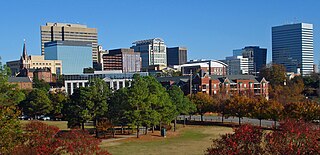
Columbia is the capital and second-largest city of the U.S. state of South Carolina, with a population estimate of 131,674 as of 2019. The city serves as the county seat of Richland County, and a portion of the city extends into neighboring Lexington County. It is the center of the Columbia metropolitan statistical area, which had a population of 767,598 as of the 2010 United States Census, growing to 832,666 by July 1, 2018, according to 2018 U.S. Census estimates. This makes it the 70th-largest metropolitan statistical area in the nation, as estimated by the United States Census Bureau as of July 1, 2018. The name Columbia is a poetic term used for the United States, derived from the name of Christopher Columbus, who explored for the Spanish Crown.
Edwin Grenville Seibels was the inventor in 1898 of the vertical filing system that has been in extensive use for over a century. Although he applied for a patent for his system, it was denied on the ground that it was only an idea, not a device.

Erie Insurance is a publicly held insurance company, offering auto, home, commercial and life insurance through a network of independent insurance agents. As of 2019, Erie Insurance Group is ranked 376th among the largest public U.S. companies, in terms of revenue, by Fortune magazine.

The Old Campus District, University of South Carolina, is a historic district centered on The Horseshoe on the main campus of the University of South Carolina in Columbia, South Carolina. On June 5, 1970, it was listed in the National Register of Historic Places. On April 19, 1996 MTV Unplugged filmed Hootie & the Blowfish's concert on The Horseshoe before the release of their second album Fairweather Johnson.

The Old North Carolina Mutual Life Insurance Company Building, also known as the Mechanics and Farmers Bank Building, is an office building at 114-116 West Parrish Street in downtown Durham, North Carolina. It formerly served as the headquarters for the North Carolina Mutual Life Insurance Company, one of the nation's largest companies founded and owned by African-Americans. The building was declared a National Historic Landmark in 1975.

The Lincoln American Tower is a 22-story building located at the corner of North Main and Court streets in Memphis, Tennessee. It is also a historical landmark, one of the first steel frame skyscrapers built in Memphis. The tower underwent a six-year refurbishing project starting in 2002, and despite a fire in 2006, is now open and accepting tenants.
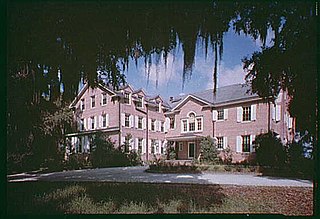
Hobcaw Barony is a 16,000 acres (6,475 ha) tract on a peninsula called Waccamaw Neck between the Winyah Bay and the Atlantic Ocean in Georgetown County, South Carolina. Much of Hobcaw Barony is south of US Highway 17. The land was purchased by the investor, philanthropist, presidential advisor, and South Carolina native Bernard M. Baruch between 1905 and 1907 for a winter hunting retreat. Later, his eldest child, Belle W. Baruch, began purchasing the property from her father beginning in 1936. By 1956, Belle owned Hobcaw Barony entirely. Upon her death in 1964, the property was transferred to the Belle W. Baruch Foundation for a nature and research preserve. The property includes more than 37 historic buildings and structures representative of the eras of both 18th & 19th century rice cultivation and 20th century winter retreats. Hobcaw Barony was named to the National Register of Historic Places on November 2, 1994.

Trinity Episcopal Church, now known as Trinity Episcopal Cathedral, is the first Episcopal and the oldest surviving sanctuary in Columbia, South Carolina. It is a Gothic Revival church that is modeled after York Minster in York, England. It was named to the National Register of Historic Places on February 24, 1971.

The House of Peace Synagogue is a former synagogue of the Beth Shalom Congregation in Columbia, South Carolina. It was originally located at 1318 Park Street. After the congregation moved in the 1935, the building was used for the Big Apple Club, which was an African-American night club. It was named to the National Register of Historic Places on August 28, 1979. In the early 1980s, the building was moved to its present location at the southeast corner of Hampton and Park Streets. In 1993, it was purchased by the Historic Columbia Foundation and is called the Big Apple.

The First Presbyterian Church is a historic church building in Columbia, South Carolina. Constructed in 1854, it was added to the National Register of Historic Places on January 25, 1971.

The B.B. Kirkland Seed and Distributing Company is a three-story historic warehouse building at 912 Lady Street in Columbia, South Carolina. It was listed on the National Register of Historic Places in 1979.
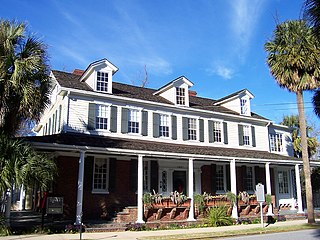
The Hale–Elmore–Seibels House or Seibels House is a historic building located in Columbia, South Carolina. Records of the exact year of its construction were destroyed in 1865 during the burning of the city by Union soldiers serving under General William Tecumseh Sherman. The best guess for the date of construction stems from a purported "1796" carved into a beam in the basement. Much of the early history of the house is uncertain, but it is thought to be the oldest building in Columbia.

The W New York Union Square is a 270-room, 21-story boutique hotel operated by W Hotels at the northeast corner of Park Avenue South and 17th Street, across from Union Square in Manhattan, New York. Originally known as the Germania Life Insurance Company Building, it was designed by Albert D'Oench and Joseph W. Yost and built in 1911 in the Beaux-Arts style.

The Charles E. Simons Jr. Federal Court House is located in Aiken, South Carolina. It is significant for its association with the many federal construction programs of the Great Depression era. The building, designed by Columbia, South Carolina architects Lafaye and Lafaye, is an excellent example of a Georgian Revival building, a style often used during the 1920s and 1930s for government buildings in smaller towns. The Court House was listed in the National Register of Historic Places on December 10, 2003.

World War Memorial Building is a building designed by Lafaye & Lafaye in Columbia, South Carolina, United States.

The Building at 1644 Main Street, also known as Tapp's Department Store, is a historic commercial building located at Columbia, South Carolina. It was built in 1940, and enlarged in 1950. It is a five- to seven-story, Depression Modern building faced in stucco and dark tremolite stone. Above the main entrance is a distinctive clock face and a sign with large freestanding letters. Tapp's Department Store closed in 1995.
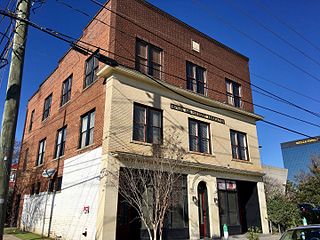
North Carolina Mutual Building, also known as the Blue Palace Tea Shop and Barber Shop, is a historic commercial building located at Columbia, South Carolina. It was built in 1909 by the North Carolina Mutual Life Insurance Company, and is a three-story, rectangular, brick commercial block. The building housed African-American businesses, professionals, and institutions during the years of Jim Crow segregation. It is located in the Washington Street business district, the city's black downtown.

Southern Cotton Oil Company, also known as Columbia Mill, was a historic cottonseed oil complex located at Columbia, South Carolina. The complex was built between 1887 and 1919. It consisted of seven industrial buildings: the Seed House, Linter Room, Press Room, Machine Shop, Oil House, Cotton Storage Room, and Storage Shed. Five of the buildings were constructed of brick and the other two were constructed of galvanized sheet metal. The complex has been demolished.

Columbia Historic District II is a national historic district located at Columbia, South Carolina. The district encompasses 113 contributing buildings and 1 contributing site in a former residential section of Columbia. They were built between the early-19th century and the 1930s and are now mostly used for commercial purposes. The buildings are in the Greek Revival, Gothic Revival, Classical Revival, and the “Columbia Cottage” styles. Notable buildings include the Robert Mills House, Debruhl-Marshall House, Hampton-Preston House, Episcopal Church of the Good Shepherd, Crawford-Clarkson House, Maxcy Gregg House, Hale-Elmore-Seibels House, St. Paul's Lutheran Church, and Ebenezer Lutheran Church.
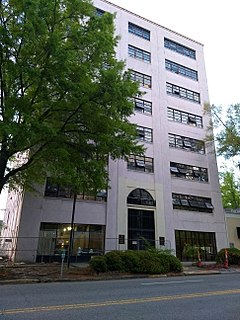
The Owen Building, known more recently as the Bruce Building, is a historic office building at 1321 Lady Street in Columbia, South Carolina. It is an eight-story concrete structure which was built in 1949 around the core of an older two-story brick building. It was designed by Lafaye, Lafaye, and Fair for local businessman Frank Owen, and was the first skyscraper built in the city after World War II. Its primary tenant for many years was Southern Bell Telephone Company, who in 1961 constructed an annex to the building to house computer equipment. It was purchased by the Seibels Bruce Insurance Company, another major tenant, in 1980. The building exterior has been relatively little-altered since its construction, and it retains some of its early internal features, including a period mail chute.























